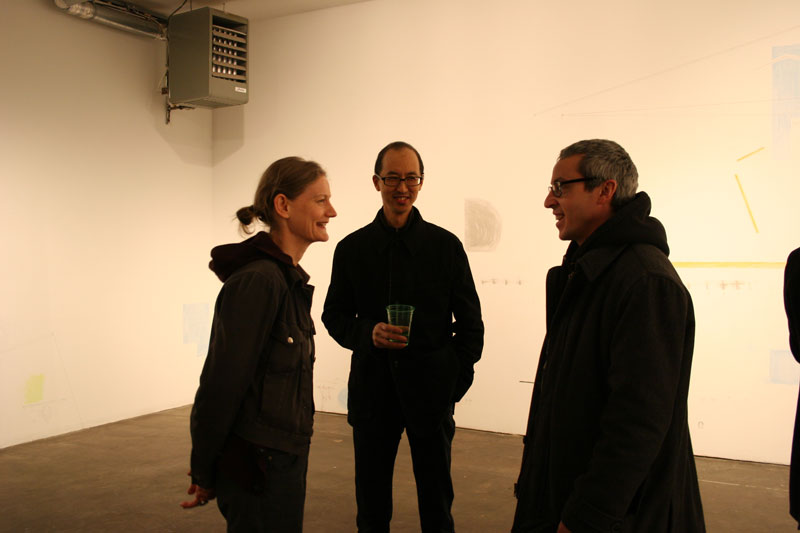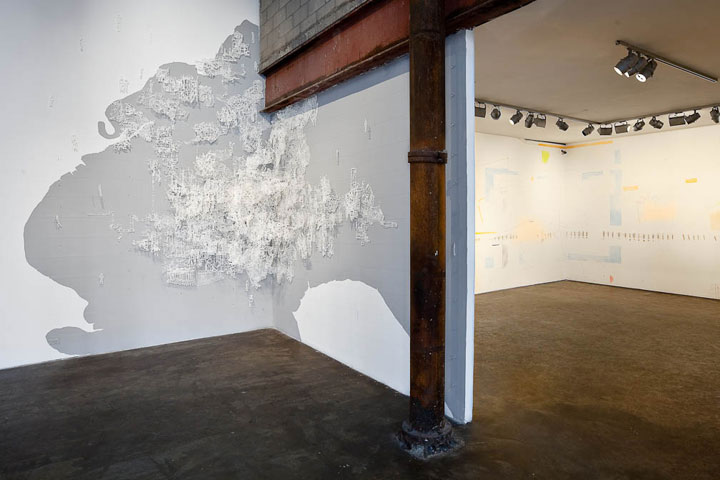Clare Churchouse, Janelle Iglesias, Hong Seon Jang, Jin Lee, Caitlin Masley, Jo Q. Nelson, Timothy Nolan, Yumi Janairo Roth,
Viviane Rombaldi Seppey, and Rob Swainston
Smack Mellon is pleased to present SITE 92: Work Permit Approved, the third exhibition in a series that features site specific installations. Smack Mellon’s expansive gallery space lends itself well to site-specific projects as the building’s uncommon architecture provides interesting points of departure for artists, as does the unique history of the building.
Originally built in the late 1800’s, the building powered Robert Gair’s manufacturing empire. Coal fired boilers, housed inside, created steam heat and energy for Gair’s nearby factories that manufactured corrugated cardboard boxes. The most unusual remnant from the building’s past is the 75-foot long coal trough that is braced to the ceiling by seventeen 18-foot high concrete and metal pillars running through the center of the gallery. The ceiling soars to 35 feet in the 5,000 square foot gallery. Twenty-five windows on two levels provide the exhibition with a picturesque backdrop of Manhattan and the East River.
The gallery also has many areas inaccessible to the public. Rob Swainston and Jo Q. Nelson explore these hidden areas. Swainston investigates the unseen space behind the gallery drywall with his large scale print installation, In Front of Behind the Wall. Three long cascading paper scrolls depict the obscured area before unraveling into abstract socio-architectural machination. Meanwhile, Nelson’s interactive installation provides viewers with access to aerial vantage points of the gallery. Viewers manually raise a pulley-mounted camera to the 35’ high ceiling while watching a live feed of the camera’s ascent.
Jin Lee’s cut paper installation responds to the industrial past of the building and its changing identity; the space once providing steam power is now a center of culture generating creative energy. As Lee intricately renders the boiler machines of the past and the cityscapes of the vibrant and newly gentrified neighborhood, her primary material, paper, gives a nod to the Gair empire.
The once industrial building now also houses Smack Mellon’s Artist Studio Program. As a past artist in residence, Janelle Iglesias’ relationship to the space is familiar and intimate. During her residency, the producer of steam heat for her was a teapot. As a result, her installation, A watched pot never boils, features a whistling teapot hanging from a bridge-like structure made of scavenged ladders, pallets and driftwood collected along the East River. The sound signifies both personal and historical use of the building while the structure is inspired by the neighboring bridges.
Viviane Rombaldi Seppey and Clare Churchouse examine the location of the building and its proximity to the East River. Rombaldi’s window installation, composed of everyday plastic bags, accentuates the relationship between the man-made and the natural environment as the imagery mimics the rippling waves of the East River which can also be seen from the gallery. Churchouse also incorporates information about the nearby river. Creating a mixed media installation that combines three-dimensional thread drawing within a narrative structure, Churchouse overlaps relational systems (timelines, language, scalar measurements) that are juxtaposed with the underground and aboveground industrial infrastructure, and land use around Smack Mellon.
Cailtin Masley and Hong Seon Jang address the viewer’s perception of the gallery space. Masley records the forms found within the gallery’s architecture and “rebuilds” the space into a series of suspended minimalist sculptures hung at eye level. Meanwhile, Jang cuts and shapes fifty years worth of National Geographic magazines mimicking the natural accretion of stalactites, emphasizing the cavernous feeling of the gallery.
Less specifically referential to the building, Timothy Nolan and Yumi Janairo Roth incorporate physical elements of the gallery in their installations. Roth creates a chain link fence made of sterling silver that encircles one of the gallery’s metal pillars. Chain link fence is routinely associated with cordoning off construction sites, demarcating private and/or abandoned property, and more recently establishing uninviting borders between the US and Mexico. Conversely the elevated value of Roth’s silver fence evokes desire for the object itself rather than the area to which it is restricting access. Meanwhile, using white and mirror laminated shapes arranged on the concrete gallery floor, Nolan creates a pattern that suggests fleeting allusions to three-dimensional forms. The mirrored surfaces reflect the ceiling and catch ambient light and colors. From one viewpoint they read as silver, like light reflecting off the water, from another they read as bright white, like pockets of rising steam.
This exhibition is made possible with public funds from the New York City Department of Cultural Affairs and the New York State Council on the Arts, celebrating 50 years of building strong, creative communities in New York State’s 62 counties and with support from The Concordia Foundation and Smack Mellon’s Members.
Smack Mellon also receives generous support from the National Endowment for the Arts and the Recovery Act, The Andy Warhol Foundation for the Visual Arts, The New York Community Trust, The Greenwall Foundation, The Robert Lehman Foundation, Lambent Foundation Fund of the Tides Foundation, Bloomberg, The Greenwich Collection LTD, Milton and Sally Avery Arts Foundation Inc., Helena Rubinstein Foundation, 2010 JPMorgan Chase Regrant Program administered by the Brooklyn Arts Council, and Foundation for Contemporary Arts.
Timothy Nolan received additional support from The Durfee Foundation.
Space for Smack Mellon’s programs is generously provided by the Walentas family and Two Trees Management.
Gallery photo by Etienne Frossard.


